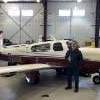M20R 2 GX - Alt Volt warning light on
-
Members Online
- raymondscott0321
- Vintagevalves
- John Car
- KLRDMD
- VWInc
- Rusty Trombone
- Aerodon
- 47U
- Scott H
- Sabremech
- milotron
- buddy
- Bob E
- Cruiser
- GaryP1007
- Jeff Uphoff
- Hank
- Rmfriday
- exM20K
- Dammit Bill
- 1980Mooney
- N252MK
- IvanP
- shawnd
- mluvara
- Crawfish
- redbaron1982
- hoot777
- eman1200
- moodychief
- kortopates
- Slick Nick
- cbarry
- sheriffburrell


Recommended Posts
Join the conversation
You can post now and register later. If you have an account, sign in now to post with your account.